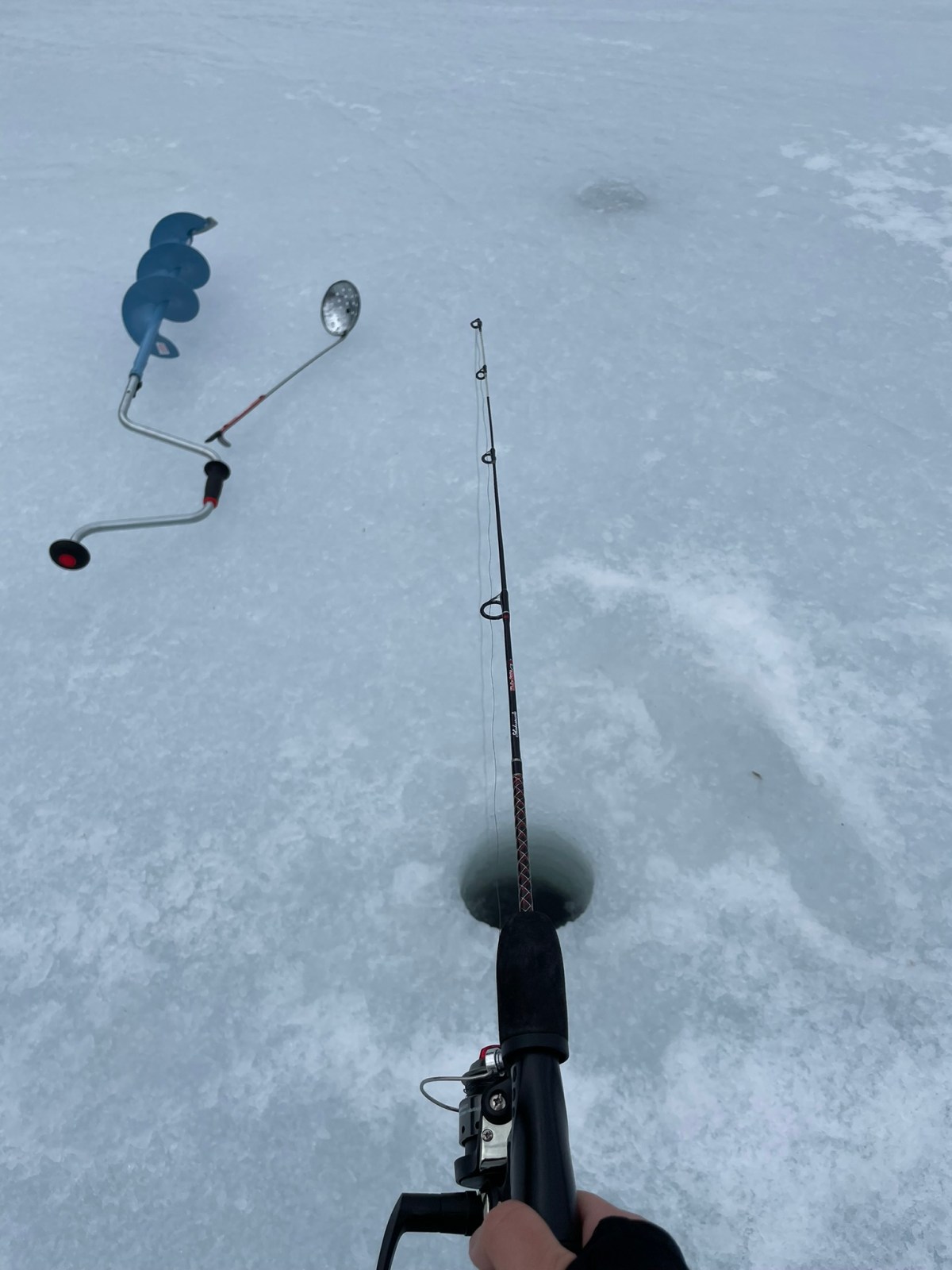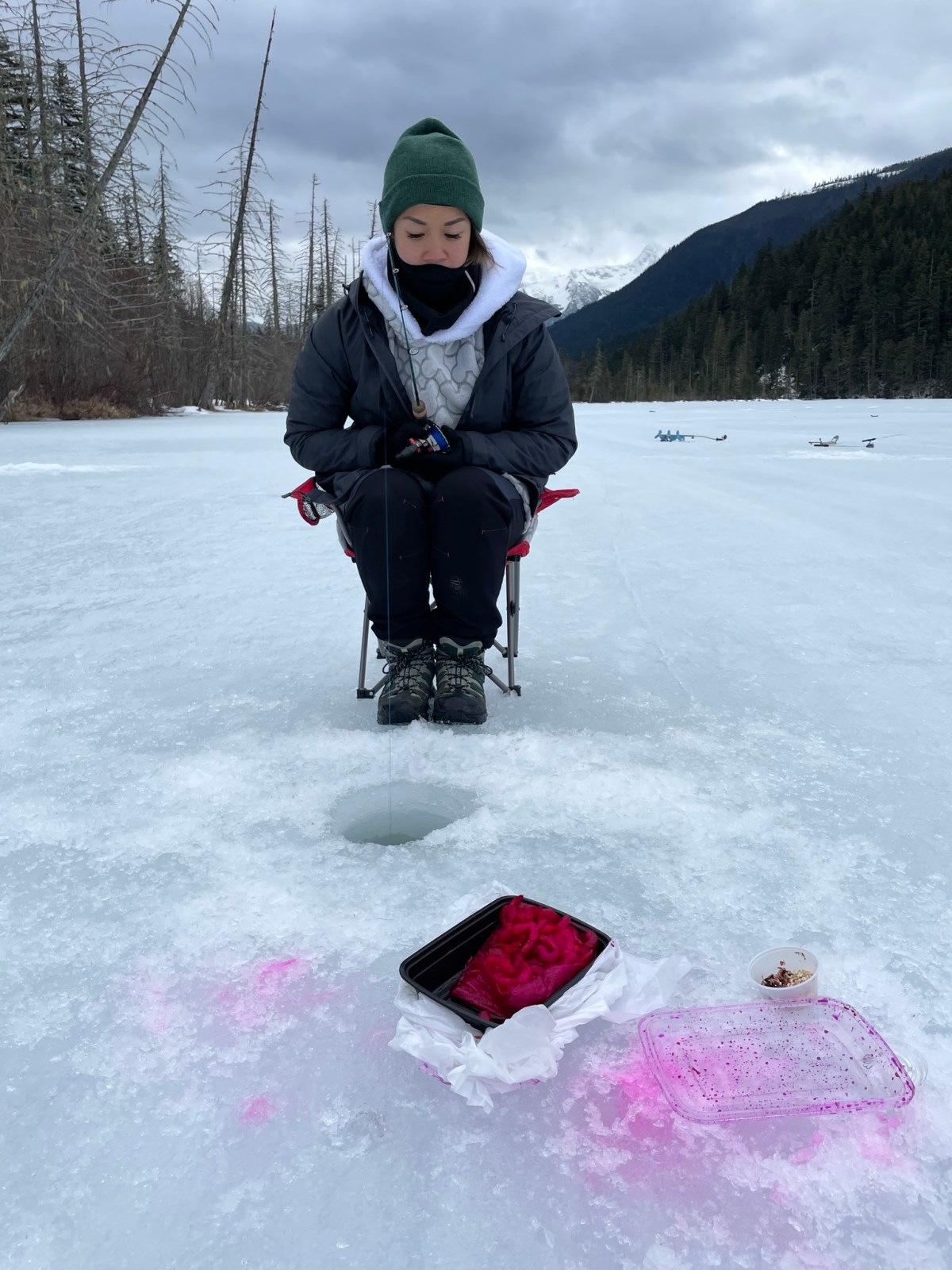I have picked up fishing as one of my covid hobbies and have found it very rewarding. Being able to enjoy the outdoors in a whole new way; now catching and cooking are experiences I deeply treasure. So when hearing that a couple of my friends were planning on doing some ice fishing, I injected myself, to be able to claim that experience too.

It is essentially trout fish on a lake, but with the necessity of having to gain access to the water first. But first getting there. You can’t do this on any lake. The temperature needs to be cold enough so that the lake fully freezes over. You have to be able to walk over the ice, and go so far as to build a fire on it. The latter is not necessary for the fishing portion, but always a fun to do when you are enjoying the great outdoors. Plus it provides warmth. Sitting stationary, waiting for your fish does get chilly.

Be sure to dress appropriately. We have invested in cold weather and waterproof gear that stands against the elements. Layering helps with thermals and fleece. Ensure hands, head, feet, and neck are properly covered. Anywhere that can loose heat fast, will.
The drive to our destination was 2.5 hours in either direction. From Vancouver to a little past Pemberton, with some mild off roading there after. So be prepared to dedicate a day to your excursion. Not to mention the time to set up and then take down, and the addition of having to wait to actually fish. And even then you might not catch anything, so set your expectations right.

We ventured out with seasoned experts so were able to rely on their knowledge of where to go and what to do, plus their tools needed to do it. My new fishing rival Yuki of @pekopekolife fame, and all sorts of fishing enthusiast Gehan at @coppertrout.
After you have parked and unloaded your vehicle, but before you set up camp; you need to suss out your perfect spot. As is the case with regular fishing, you want to go where the fish are, and they do move. The edges of the water seem to be a safe bet. The water isn’t too deep there, so you don’t have to drop your line down too far. The ice is stable, and the fish are found stationary.

You need to drill a hole to drop your line to see if you get a bite. Doing so requires a special handheld drill. A metal spiral with a handle you crank. A literal manual drill to penetrate the snow and ice. The goal is to hold said drill it as even as you can, and churn. It is hard work. But as soon as your hit water, you pull out.
Next you clear the debris of shaved snow and and use another speciality tool to scoop any of the excess snow out from your water hole. You want to be able see down said hole clearly. This tool literally looks like a cooking sieve that you would use while frying with a wok.

Now to bait your hook. Ice fishing uses a smaller, very malleable rod and reel. Much like a regular small rod you would use for trout, which is typically a smaller fish. For bait our hosts brought live grubs and fermented shrimp they prepared and dyed neon fuchsia themselves.
With tempting treats in hooks, and flashy spinners on lines, you drop both down to the very bottom of the lake. When your line buckles you are there. You then crank up a rotation or so, as majority of experienced fisherman believe that is where the fish linger.

However, myself and my guest would both catch our first, and only trout of the day closer to the top of the ice. And as soon as we caught our one, our group deemed the spot “camp”.

When fishing for trout, you are looking for a light nibble, so you have to pay close attention. You pull hard and quickly upward when you feel the slightest vibration. If done successfully you can now reel your catch in. They put up a fight, but on average you are much larger. It is worth noting here that you do need your licence and Fisheries and Oceans Canada does check. So do your research before you get a hefty fine.

We would keep our catch to cook as a snack over open fire. However common practice is to catch and release, as trout offer little meat and a lot of work. You can easily grill trout by a crackling fire, but I put in the extra mile to remove the guts and to scale the fish; before they were skewered and roasted over our open flame.

Eat as is, but we travel with a portable spice kit for easy seasoning. Be warned, there are little bones that need to be picked out. But the experience of catching and cooking is one of pride, and the ability to do so is more reward that the sustenance it provides.

At our particular spot we were visited by ravens who gobbled up the guts and tiny birds that scavenged for meaty morsels. The latter were even willing to land on your hand for a literal hand out.
As we continued to fish, in hopes of adding to our count we would sit and talk. Drinking and eating are a big part of this. So bring folding chairs and blankets for laps.

Yuki would prepare for us a warming lunch of Korean beef bone soup. You do burn calories quicker, trying to stay warm. So soup and the Korean sushi she packed was ideal in these cold conditions.

With renewed energy would continue our attempts to catch trout. Carving new holes and moving to existing ones in the hopes of changing our luck. Our snack of chai and ginger cookies helped to pick up our spirits and energy, mid way.

When the sun started to set, our fire had long burned out, and the wind started to gust; we would take our fishing indoors. Our hosts had a fishing tent. Snug for 4, but we made it work. Folding chairs back to back, each facing our own fresh hole. In its covered darkness you can actually see clearly down the water hole, and where your spinner ends.
As the darkness grew imminent and the ice began fissuring, we decided to pack up and head home with a total of 3 fish between 4 people. 2 eaten, 1 caught and released.
Lots of work but lots of pride and reward from this one.





